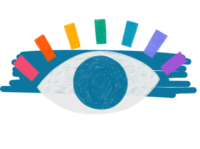As a consultant ophthalmologist specializing in pediatric ophthalmology, it’s crucial to have a deep understanding of common vision problems that affect children. Two prevalent refractive errors that you will frequently encounter in your practice are hyperopia (farsightedness) and myopia (nearsightedness). In this comprehensive guide, we will explore both conditions, their causes, symptoms, diagnosis, and management strategies specific to pediatric patients.
Understanding Hyperopia (Farsightedness)
Hyperopia, commonly known as farsightedness, is a refractive error where distant objects can be seen more clearly than nearby objects. In children, hyperopia often occurs due to a shorter-than-average eyeball or a cornea that is less curved than normal. This results in light rays focusing behind the retina instead of directly on it.
Causes of Hyperopia in Children:
Genetics: A family history of hyperopia can increase a child’s risk.
Underdeveloped eye: In some cases, a child’s eyes may not have fully developed yet.
Symptoms of Hyperopia in Children:
Difficulty focusing on close objects, such as reading or writing.
Eye strain or headaches, particularly when performing near tasks.
Squinting or closing one eye to see objects up close.
Fatigue or discomfort during or after close-up activities.
Diagnosis and Management of Hyperopia
Diagnosing hyperopia in children involves a comprehensive eye examination, including a visual acuity test and a refraction assessment. It’s essential to detect hyperopia early to prevent potential vision problems in the future.
Management Strategies for Hyperopia in Children:
Prescription Glasses: For mild to moderate hyperopia, corrective eyeglasses are typically prescribed to help children see clearly at all distances.
Contact Lenses: In some cases, contact lenses may be recommended, especially for older children who are responsible enough to care for them.
Vision Therapy: Vision therapy exercises can be beneficial for some children, particularly those with accommodative problems.
Understanding Myopia (Nearsightedness)
Myopia, also known as nearsightedness, is a common refractive error where distant objects appear blurry while close objects are seen clearly. In myopia, the eyeball is often longer than average, causing light to focus in front of the retina rather than directly on it.
Causes of Myopia in Children:
Genetics: A family history of myopia significantly increases the risk.
Environmental Factors: Extensive near work and limited outdoor activities may contribute to the development and progression of myopia.
Symptoms of Myopia in Children:
Squinting or narrowing of the eyes to see distant objects.
Frequent eye rubbing.
Complaints of blurry vision, particularly when looking at distant objects.
Potential academic challenges due to difficulty seeing the board or distant text in the classroom.
Management Strategies for Myopia in Children:
Prescription Glasses or Contact Lenses: Corrective eyewear, such as glasses or contact lenses, is commonly prescribed to help children with myopia see distant objects clearly.
Orthokeratology (Ortho-K): This specialized treatment involves the use of specially designed rigid contact lenses worn overnight to reshape the cornea temporarily. This can reduce myopia progression in some children.
Atropine Eye Drops: Low-dose atropine eye drops have shown promise in slowing down the progression of myopia in children. They are typically prescribed by ophthalmologists after a thorough evaluation.
Behavioral Interventions: Encourage children to spend more time outdoors and limit screen time to reduce the risk of myopia progression. Additionally, implementing the 20-20-20 rule (taking a 20-second break every 20 minutes to look at something 20 feet away) can help reduce eye strain.
Conclusion
As a consultant ophthalmologist specializing in pediatric ophthalmology, you play a vital role in diagnosing and managing vision problems like hyperopia and myopia in children. Understanding the causes, symptoms, diagnosis, and management strategies for these refractive errors is essential to provide the best possible care for your young patients.
By staying up-to-date with the latest research and treatment options, you can help children maintain healthy vision and improve their quality of life. Regular eye examinations and early intervention are key to managing hyperopia and myopia effectively in the pediatric population, ensuring that children can see the world clearly and reach their full potential.
